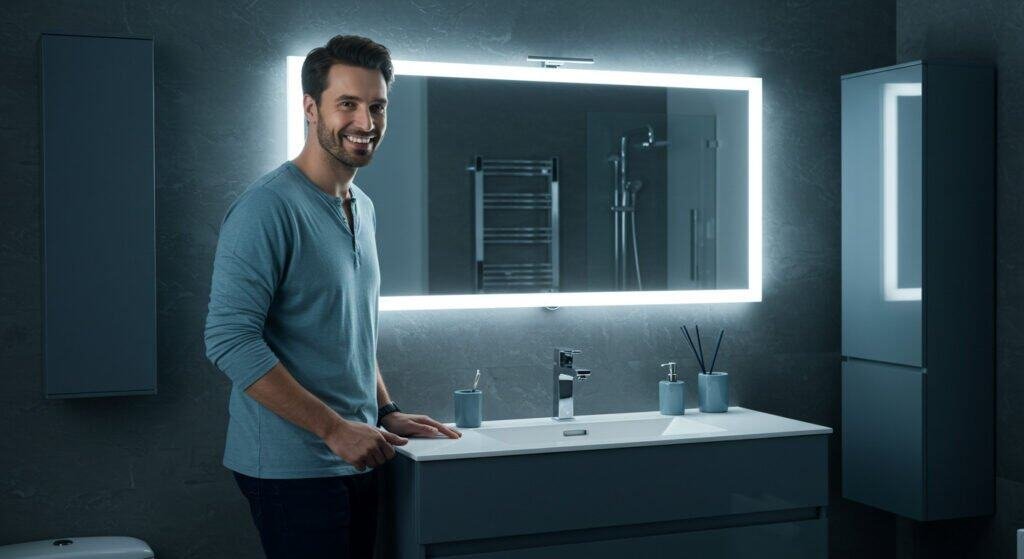How to clean bathroom mirror? Foggy bathroom mirrors with stubborn water spots and soap residue create daily frustration when you’re trying to get ready. These unsightly streaks and film not only obstruct your reflection but also diminish the elegant appearance of your modern bathroom mirror and vanity setup.
The best way to clean mirrors without streaks involves using the right cleaning solution, proper technique, and suitable tools. Start with a microfiber cloth and either commercial glass cleaner or homemade solution, then wipe in straight lines from top to bottom for crystal-clear results on any glass mirror surface.
Let’s explore comprehensive methods and professional techniques to achieve perfectly clean mirrors every time.
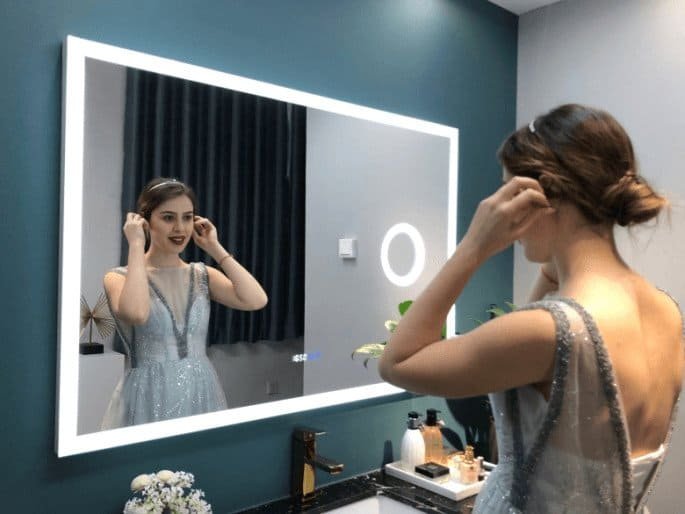
What Cleaning Solutions Work Best for Bathroom Mirrors?
Different cleaning solutions work better for different types of staining or residue on your bathroom vanity mirror. Whether it is a backlit mirror, an led mirror, or a standard mirror, here are some things to consider.
Commercial glass cleaners specifically formulated for mirrors provide consistent results, while homemade solutions using distilled water and white vinegar offer cost-effective alternatives. The best mirror cleaner depends on your specific cleaning needs and mirror type.
When dealing with an led vanity mirror, a lighted vanity mirror for the bathroom, or any type of backlit mirror, you can’t use anything with ammonia. You have to be very careful about that, especially today, because most mirrors have a protective coating on them. The last thing you want to do is have any type of ammonia get in and start to break that coating down because then you’re going to have a big expense on your hands. Ammonia-based products are not the money saver you once thought. Stick with the white vinegar and water solution. It works every time.
If you’ve got some tough buildup on your bathroom vanity mirror, you can mix isopropyl alcohol with distilled water (1:1 ratio), and you’ll be able to get in there and clean it off. If you have soap scum on lighted bathroom mirrors and a regular bathroom mirror with lights (possibly a led bathroom mirror), just add a little bit of dish soap to help with the cleaning. The key here is if you’re going to try something new, give it a little spot test on a small, inconspicuous area to make sure you’re not going to affect the entire surface.
How to Clean Mirrors Without Leaving Streaks?
To clean your vanity mirror and to get it streak-free, you have to understand what’s causing those annoying lines and marks.
The key to cleaning glass mirrors without streaks lies in using the correct motion pattern and avoiding circular wiping. Always clean from top to bottom in straight, overlapping strokes to prevent cleaning solution from dripping onto already-cleaned areas.
To get your vanity mirror clean, to get away from streaks, you have to understand what’s causing them. The solution concentration, the moisture in your cloth, and the pressure and type of wiping you do are the three variables you have to control. If your backlit mirror or your led bathroom mirror isn’t looking clear for you and you just cleaned it, you probably didn’t let it dry all the way. Why? Because you can see streaks when it’s still wet and you could still see streak after streak after streak as it dried. Be patient, wait for the mirror to dry completely, and then do what you got to do.
This is especially true when cleaning lighted bathroom mirrors, given the electrical integration with those units. This is also why microfiber works incredibly well. Your microfiber cloth needs to be damp enough to get water on your mirror but not soaking wet. If it’s too wet, you leave streaks and you force the cleaner to spread more thinly than it needs to be. Make sure your mirror is cool to the touch. If your mirror is hot, the cleaning solution will want to evaporate too quickly, and you could end up with residue behind.

How to Clean a Mirror Without Windex?
Many homeowners prefer alternatives to commercial cleaners when maintaining their bathroom light mirror and other reflective surfaces.
Effective Windex alternatives include white vinegar solutions, rubbing alcohol mixtures, and dish soap combinations. These homemade cleaners work excellently on led light mirror vanity setups and provide streak-free results without harsh chemicals.
Make sure to mix equal parts white vinegar and distilled water in a spray bottle to create an effective Windex substitute. For your makeup mirror, if you’re going to add anything to help clear the oils and residue, mix in one tablespoon of cornstarch per cup of water and vinegar. Also, consider using two cups of distilled water, half a cup of rubbing alcohol, and a quarter cup of white vinegar to make the solution.
This works especially well with the modern lighted mirrors they have in bathrooms everywhere because it evaporates quickly and doesn t leave any residue. If you have a mirror that has a lot of buildup on it, use a paste made of baking soda and water. Coat it in the paste, rinse it off gently, then hit it with this solution and you’ll be amazed.
How to Clean a Mirror Without Vinegar?
Some individuals avoid vinegar due to its strong odor or potential interactions with certain mirror coatings found on contemporary bathroom mirrors.
Rubbing alcohol solutions, dish soap mixtures, and specialized glass cleaners provide excellent vinegar-free alternatives. These options work effectively on led mirrors and wall mirrors with lights without the distinctive vinegar smell.
In a spray bottle, create a solution of two cups distilled water and half a cup of rubbing alcohol, and add two drops of liquid dish soap. This solution magically cleans mirrors you might have installed with black frames or rectangular mirrors in the bathroom. It leaves nothing but clean glass; there is no residue of vinegar or anything else. Another gentler solution to try is a mixture of one cup distilled water and two tablespoons of liquid fabric softener; it will clean off anything that ’s on the mirror and give you a nice, sweet smell.
Additionally, just distilled water in a spray bottle with a high-quality microfiber cloth is often all you need to keep your makeup mirror clean and streak free. If you have a spot that just won’t come off, put a little bit of non-gel toothpaste on there and use it as a gentle abrasive. Spray your water, alcohol, and vinegar solution on it afterward and clean it off.

How to Clean a Mirror That is Hazy?
Hazy mirrors typically result from hard water deposits, cleaning product buildup, or age-related deterioration that affects the reflective quality of your bathroom mirror.
Remove haziness by using stronger cleaning solutions and gentle abrasive techniques. Start with a vinegar solution, then progress to specialized treatments if the cloudiness persists on your modern bathroom mirror surface.
To remove the film on LED bathroom mirrors, apply straight white vinegar to the affected area and allow it to sit for five minutes before wiping it off. If it hasn’t come off yet, use a paste of baking soda and water. Coat whatever the affected area is in baking soda paste, rub it in circular motions, then rinse.
If the cloudiness doesn’t come off, you’re not looking at cloudiness. You’re looking at where the backing to the reflector has been damaged in some way. Then, you’re into replacing the mirror. If your bathroom vanity light fixtures have been attacked and look like they have mineral deposits on them, you’ll have to scrape that off first with a plastic scraper before you start spraying and calming these cleaning solutions down. Also, it’s essential to work in small areas when dealing with a haze so that nothing dries out on you.
What Tools Do You Need for Professional Mirror Cleaning?
Professional mirror cleaning requires specific tools that prevent scratching while ensuring thorough cleaning of modern bathroom mirrors and specialty installations.
Essential tools include microfiber cloths, squeegees, spray bottles, and soft-bristled brushes. Quality tools make significant difference in achieving streak-free results on led mirrors and other reflective surfaces.
The number one thing that you want to use is a microfiber cloth. The weave on microfiber traps and holds dirt and moisture without scratching the delicate surface of your glass. Second, for big rectangular mirrors in your bathroom, get a professional-grade squeegee. You want a squeegee that you will see them use at a gas station or a truck stop. Get one of those to help make the job of cleaning your mirror easier. Also, don’t use the same cloth throughout the entire process. Use one cloth that’s mildly damp to clean with your solution (described in a moment) and a completely dry microfiber cloth to polish.
When you get around a lighted makeup mirror, specifically if you have a really pretty light fixture on it, take a cotton swab around the fixture, making sure to clean every nook and cranny. The design of the light will add a lot of charm to the space. Invest in a little tool with a telescoping handle on it that you can wash windows with. Use that to get up on there and clean your big wall mirrors above your sinks without having to get up on top of a chair or your countertops or anything else. Here’s something else, when you wash those microfiber cloths, wash them by themselves and don’t use any fabric softener. Washing them in fabric softener will render them ineffective when you’re dealing with backlit mirrors.
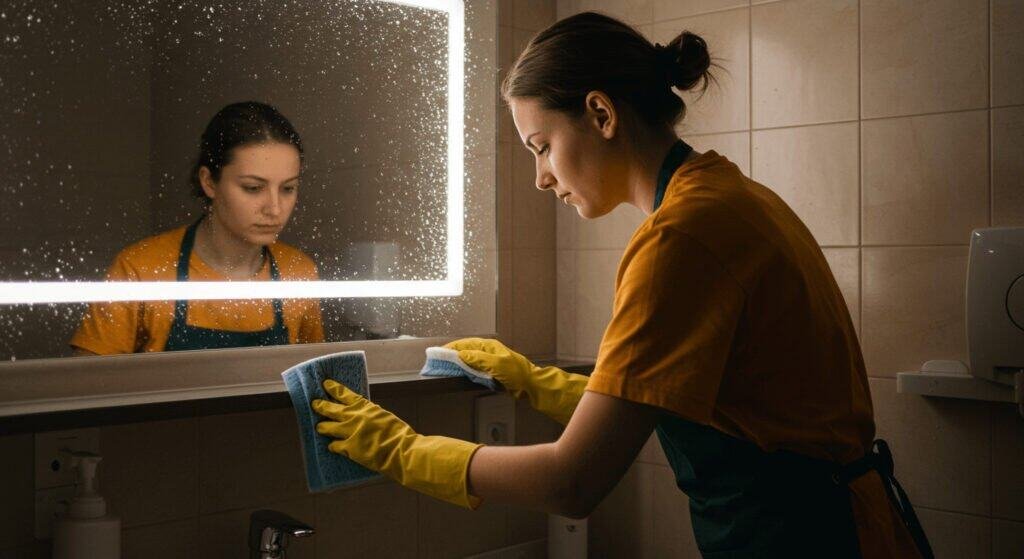
How to Clean Mirror Stains at Home?
Different types of stains on bathroom mirrors require specific approaches for complete removal without damaging reflective surfaces.
Common mirror stains include water spots, soap scum, toothpaste splatter, and cosmetic residue. Each stain type responds best to targeted cleaning methods using household products readily available in most homes.
White vinegar by itself is excellent for taking water spots off an LED vanity mirror. Just apply it with a clean microfiber cloth and you’re good to go. If you’ve got soap scum on the mirrors around a lighted makeup mirror, mix equal parts dish soap and white vinegar. Put that on the mirror with a soft cloth, then rinse it with clean water. If you have toothpaste stains on your mirrors around your vanity lights, use warm water and a little bit of mild dish soap in combination with a soft-bristled toothbrush.
That’s all it is; it’s oil. So you’re going to have to break it up and move it out with either makeup remover that you might apply to a cotton round, or with rubbing alcohol. If you have a red wine, coffee or tea stain on your wall mirror, around your lighted vanity mirrors, consider making a paste out of cream of tartar and lemon juice. Coat the stain with the paste, wait a couple of minutes, and wipe it away with a damp cloth.
| Stain Type | Best Cleaning Solution | Application Method | Removal Time |
|---|---|---|---|
| Water Spots | White Vinegar (undiluted) | Direct application with microfiber cloth | Immediate |
| Soap Scum | Dish soap + White vinegar (1:1) | Apply, wait 2 minutes, rinse | 2-3 minutes |
| Toothpaste | Warm water + Mild dish soap | Soft brush application | 1-2 minutes |
| Cosmetic Residue | Rubbing alcohol or makeup remover | Cotton pad application | 30 seconds |
| Hard Water Deposits | Baking soda paste | Gentle circular scrubbing | 5 minutes |
What Should You Not Clean Mirrors With?
Certain cleaning products and tools can permanently damage mirror surfaces, particularly on modern led bathroom mirrors with specialized coatings.
Avoid abrasive cleaners, paper towels, newspaper, and ammonia-based products. These materials can scratch reflective surfaces or damage protective coatings on contemporary lighted mirrors for bathrooms.
Never use anything that has a grit in it like Comet, Bar Keepers Friend, Soft Scrub, or any of those things on a mirror. They will ruin the mirror. They will scratch the glass, and you will not be able to get rid of the damage. Never use anything that contains bleach to clean your lighted vanity mirror in your bathroom. It is advisable to not use anything with bleach because it’s going to work its way past the reflective backing, if you have a mirror that’s been attacked, and it’s going to get to the electrical parts behind the mirror. Then, you’re replacing the fixture and the mirror.
Avoid using paper towels and newspaper as they can leave lint and may cause micro-scratches on the surface of your LED light mirror vanity. Never let ammonia-based products touch modern bathroom mirrors as it can break down the protective backing and damage the mirror. Also, be cautious using dirty or contaminated cloths as they can deposit grit and debris on your bathroom vanity mirror, potentially causing permanent damage to the reflective surface.
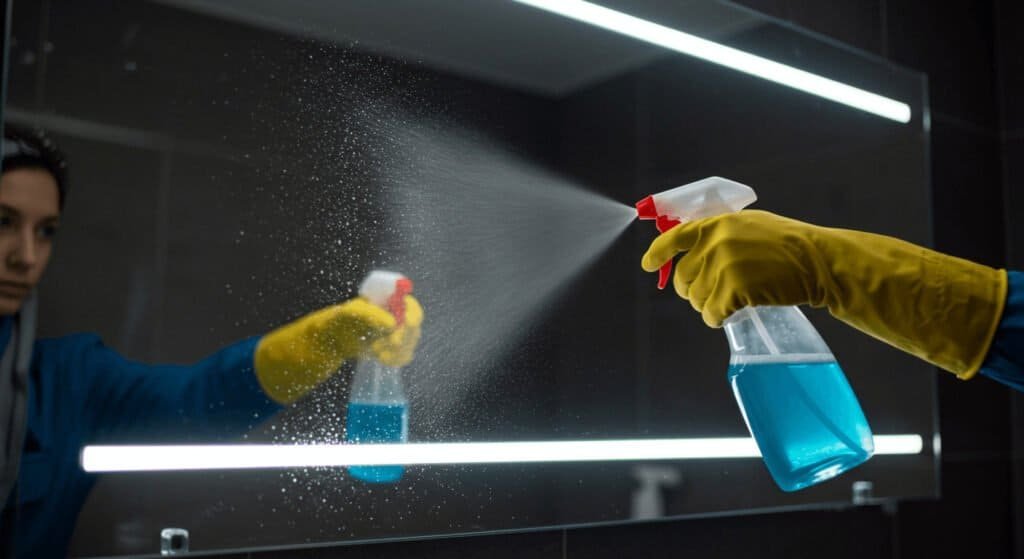
Can I Use Clorox Wipes on My Bathroom Mirror?
Clorox wipes contain chemicals that may interact negatively with mirror coatings and should be used cautiously on bathroom mirrors.
While Clorox wipes provide convenient cleaning, they contain bleach and other harsh chemicals that can damage certain mirror surfaces. Use them sparingly and test on inconspicuous areas first, particularly on led mirrors.
Clorox wipes can safely clean basic glass mirrors occasionally, but frequent use may degrade reflective coatings on modern lighted mirrors for bathrooms. The bleach content poses particular risk to led bathroom mirror electrical components and can cause discoloration around vanity lights mounting areas. If using disinfecting wipes on your lighted vanity mirror, immediately follow with a damp microfiber cloth to remove chemical residue, then dry thoroughly.
For routine cleaning of bathroom vanity mirrors, stick to gentler alternatives that won’t compromise the longevity of your vanity mirror with led lights investment. When disinfection is necessary for health reasons, apply Clorox wipes sparingly to the mirror surface only, avoiding any electrical components or mounting hardware on your backlit mirror installation.
Can I Use Windex on a Mirror?
Windex represents one of the most popular commercial glass cleaners, but its suitability depends on your specific mirror type and cleaning needs.
Windex works effectively on standard glass mirrors and provides streak-free results when used correctly. However, exercise caution with led mirrors and other electronic mirror installations due to ammonia content.
Traditional blue Windex cleans bathroom mirrors effectively, but the ammonia content can potentially damage coatings on modern bathroom mirror installations over time. For led vanity mirrors and lighted bathroom mirror systems, choose ammonia-free Windex formulations to protect electrical components and specialized coatings.
Apply Windex to your cleaning cloth rather than spraying directly onto lighted vanity mirrors for bathroom use to prevent moisture from reaching electrical connections. When cleaning large rectangular bathroom mirrors, Windex provides consistent results across the entire surface without streaking. For small bathroom mirror installations with intricate designs, dilute Windex slightly with distilled water to reduce chemical concentration while maintaining cleaning effectiveness on your wall mirror with lights setup.
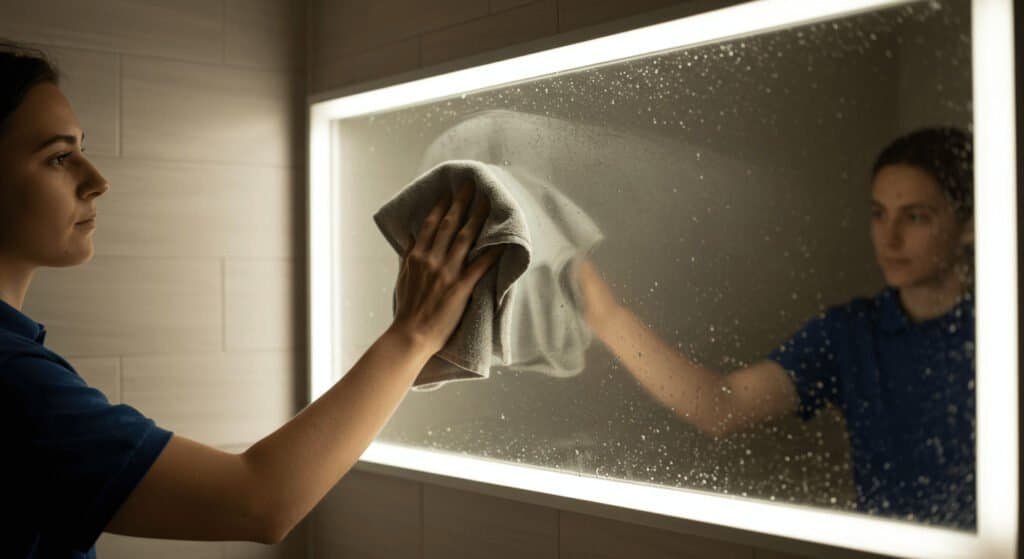
Can You Use Paper Towels to Clean Mirrors?
Paper towels remain a common choice for mirror cleaning, but they present several disadvantages compared to specialized cleaning cloths.
Paper towels can leave lint, create streaks, and potentially scratch mirror surfaces. While convenient, they’re not the best choice for achieving professional results on bathroom mirrors and led mirror installations.
Paper towels work acceptably for emergency cleaning of your bathroom light mirror, but they leave microscopic fibers that become visible under proper lighting conditions. The texture of paper towels can create fine scratches on delicate lighted makeup mirror surfaces, particularly when dust or grit is present.
For optimal results on your led light mirror vanity, paper towels should only be used for initial debris removal before switching to microfiber cloths for actual cleaning. When cleaning modern lighted mirrors for bathrooms, paper towel fibers can interfere with lighting elements and create shadows or spots in the illumination. If paper towels are your only option, choose high-quality, lint-free varieties and use them gently on your light up vanity mirror surface, following immediately with a proper microfiber cloth for final polishing.
| Cleaning Tool | Streak Risk | Scratch Risk | Lint Residue | Best Use Case |
|---|---|---|---|---|
| Microfiber Cloth | Very Low | Very Low | None | Regular cleaning, all mirror types |
| Paper Towels | High | Medium | High | Emergency cleaning only |
| Newspaper | Medium | Low | Medium | Occasional use, traditional mirrors |
| Cotton Cloth | Medium | Low | Low | Gentle cleaning, antique mirrors |
| Squeegee | Very Low | Very Low | None | Large mirrors, professional cleaning |
How to Prevent Bathroom Mirror Fogging and Water Spots?
Prevention strategies significantly reduce cleaning frequency and maintain the pristine appearance of your bathroom vanity mirrors and lighting installations.
Proper ventilation, regular maintenance, and protective treatments help minimize fogging and water spot formation. These preventive measures work particularly well with modern lighted mirrors for bathrooms and led mirror systems.
Install adequate bathroom ventilation to reduce moisture accumulation that causes fogging on your led bathroom mirror and creates conditions for water spot formation. Apply commercial anti-fog treatments designed specifically for bathroom mirrors, or create a homemade solution using liquid dish soap applied with a microfiber cloth and buffed to invisibility.
For backlit mirror installations, ensure proper spacing from shower areas to minimize direct water contact. Regular daily maintenance using a dry microfiber cloth prevents buildup that requires intensive cleaning of your lighted vanity mirrors for bathroom use. Consider upgrading to modern bathroom mirror designs with built-in defogging features that use gentle heating elements to prevent condensation formation. Position vanity lights strategically to minimize shadows that can hide developing water spots on your vanity mirror with led lights installation.

Conclusion
Achieving streak-free bathroom mirrors requires proper techniques, suitable cleaning solutions, and appropriate tools. Regular maintenance using these professional methods ensures your led mirrors and modern bathroom mirror installations remain crystal clear and functionally beautiful for years to come.
- Clik here to know What Is Copper Free Mirror?
- If you donot know how too choose the right bathroom height click here.
- Know more about LED bathroom mirror Problems
- Clik here to know why Touch Sensor Mirror Not Working
- Clik here to know What Are Standard Vanity Mirror Sizes?
- Clik here to know Why Are Mirrors So Expensive?
- Clik here to know Do LED Mirrors Need Electricity?
- Clik here to know Is a Lighted Mirror Enough Light for a Bathroom?
- Find out 10 Common LED Bathroom Mirror Problems Click Here

